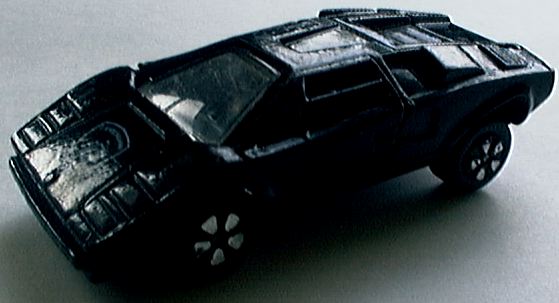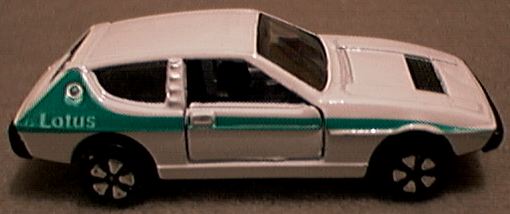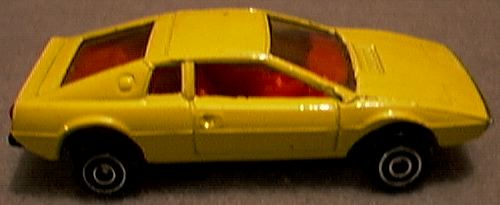Toy Box Treasurers - Playart II
By Doug Breithaupt


The Playart story continues with material provided by Brian Willoughby
of Kentucky. On this page and the 'Playart III' page linked below, I am
pleased to offer Brian's excellent information on Playart with minimal editing.
The Playart car to the right is the Porsche Carerra 910.
As I am sure you are aware, information on Playart, both the company and
it products, is very limited. I never really intended to begin assembling
a collection of them; I own a 1960 Land-Rover, so naturally, I collect Land-Rover
or Range Rover miniatures. I was trying in vain to find the Range Rover
model produced by Playart when I "rediscovered" them (I ended
up paying $12 for a loose copy of the Rangie). I had a few left from my
childhood and, I guess mostly out of nostalgia, I began picking them up
here and there. I noted that their construction was considerably better
than some of the competition and, generally, the castings had a certain
charm. Although the wheels and interiors often left a bit to be desired,
the majority of Playart's models featured all-metal construction during
a period when other manufacturers (most notably Matchbox's and Corgi's parent
companies of Lesney and Mettoy, respectively) were abandoning cast zinc
baseplates in favor of molded plastic. Pick up a Playart: the models are
heavy for their size and remarkably robust.
Another reason I was attracted to them was that Playart modeled some of my favorite cars: the Jensen FF, the Austin Mini Cooper S, the Datsun 240Z, the BMW 2002 and, of course, the Range Rover. Furthermore, they produced a wide array of rarely modeled cars: for example, who else did a Volvo 343 or 164E in 1:64? Sure, there were a few models of the elegant and appealing Volvo P1800 sports car; yet, models of Volvo's durable sedans were a different story. And did anyone else ever offer such an extensive selection of Lamborghini models (the Miura, the Countach, the Marzel, and the Silhouette) in 1:64? Furthermore, the Playart range was well-balanced: unlike Matchbox and Tomica, both of which tended to predominately offer models of cars produced in their home countries, Playart featured models of cars from England, the United States, Germany, Sweden, Japan, Italy, France and even Czechoslovakia (in the form of the Czech-produced Zetor tractor).
Overall, I've found the Playarts to be quite accurate models; however, there are exceptions like the Honda S800 which is a terrible model of that car. The actual car was tiny little thing, smaller than an Austin-Healey Sprite, yet the Playart model makes it appear much longer and bigger (and handsomer) than it should. Another misstep was the Mercedes-Benz 350SL which had red (yes, red) headlamps. Apparently, a piece of transparent red plastic ran the length of the model and was used for both sets of lamps, front and rear. Also, the very earliest of castings had a single, one-size-fits-all wheel and tire combination which, although fine on smaller-scaled cars, can detract from the appearance of larger ones. The Lamborghini Miura (shown in this article) has this type of wheel. The Toyota 2000 GT Convertible (shown in this article) has the second-type wheel. The tires riding on this wheel center also came in short and tall profiles depending on the model. That wheel was replaced by the one-piece "five star" wheel which is the most common wheel variant. I have named these wheels the "Fuchs" wheel after the Fuchs forged alloy wheels used by Porsche on 911s around the same time. Look at a '73 911S: the Playart wheel looks very similar. These wheels came in at least two different diameters as well. The last-type wheel was the five-dash pattern as used on the Rolls-Royce Silver Shadow (shown in this article). There are several other wheel types including ones for race cars, trucks, off-road vehicles (like the VW Kubelwagen) and tractors. I never have attempted to decipher or catalogue any of these wheel variations. Keep in mind that these are my own wheel designations and names; they follow no conventions and other collectors probably use something completely different. The article continues following the eight Playart diecast images below.
Here are the next eight Playart models in my collection.
Full image profiles for each is linked to my 'minicars'
list.
 .
. .
. .
.
1980 Lamborghini Countach - 1968 Lamborghini Miura - 1975 Lamborghini Silhouette
- 1970 Range Rover
 .
. .
. .
.
1970 Lancia Fulvia 1600 HF - 1975 Lotus Elite - 1978 Lotus Esprit - 1972
Mercedes-Benz C-111
From what I know of them, the character models are the most heavily sought Playarts. The Batmobile, whose licensing and approval from D.C. Comics seems questionable (was it sanctioned?) is very rare and when it does trade hands it is usually at a level over $100. The Man From Uncle Car is similarly rare and also infrequently seen (perhaps appropriately so for a spy car); it also sells at indecent prices. For those of us not into character collectibles, the Volkswagen Microbus (labeled a "Station Wagon" by Playart) is probably the most coveted model in the line-up (it's a delicate casting unfortunately prone to damage). Also ensuring its position as one of the top Playarts, is the fact that it's a 21-window Microbus, not the much more commonly modeled 23-window version. Since it is one of few or possibly the only model of the 21-window Microbus, Volkswagen completists consider it a must-have for their collection. Others that are considered highly desirable include: the Opel GT (making a rare appearance in 1:64), the VW-Porsche 914 (the price of which is driven up by demand among both Volkswagen and Porsche collectors--I've seen this one priced at $25-$30 loose!), the circa-1970 Ford Thunderbird and any of the American Muscle cars (Ford Mustang, Chevrolet Camaro, Pontiac Firebird, AMC Javelin, etc.) The BMW 2002, while probably not any rarer than the any of the others, is also a must-have for all the Bimmerheads who worship these great little sedans. For the most part however, even the rare ones, as well as those in high demand among collectors of certain makes of cars, can be bought for virtually nothing since Playarts are the Rodney Dangerfields of 1:64 diecasts. The most I have ever paid for one was what I paid for my Range Rover.
All 1:64 scale Playart models are all hard to find, irrespective of condition. Color variations abound and most models must have been produced in at least five different paint schemes: if you don't like the color of a certain model, never fear, you'll probably find it someday in another. Concerning the accuracy of the model's colors, Playarts are no more garish than contemporary offerings from the competition; in fact, many tend to be slightly more believable as colors that might have actually been used on the models' prototypes.